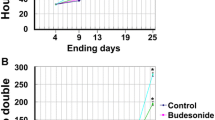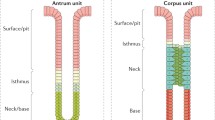Abstract
Gastric mucosal cell migration and proliferation are crucial events in the repair of gastric mucosal erosions. This study was designed to test the hypothesis that the H2 blockers roxatidine and ranitidine might stimulate migration and proliferation of gastric mucous cells derived from a human well-differentiated gastric adenocarcinoma cell line (MKN 28 cells)in vitro, in conditions independent of systemic factors and of acid inhibition. Confluent monolayers of MKN 28 cells were wounded with a razor blade and were then incubated with roxatidine or ranitidine. The number of cells migrating to the damaged area was determined 24 hr later. Cell proliferation was assessed by means of [3H]thymidine uptake and cell counts after incubation with roxatidine or ranitidine. Neither H2 antagonist significantly stimulated cell migration. On the other hand, cell proliferation was dose-dependently and significantly enhanced by incubation with roxatidine and ranitidine. Exogenous administration of TGF-α significantly stimulated MKN 28 cell division. However, incubation with roxatidine or ranitidine did not increase the steady-state mRNA expression of TGF-α or EGFR as assessed by northern blot analysis. Based on thesein vitro findings, we postulate that the ulcer healing effect of these H2 antagonistsin vivo might be due in part to stimulation of gastric mucosal cell proliferation.
Similar content being viewed by others
References
Rutten MJ, Ito S: Morphology and electrophysiology of guinea pig gastric mucosal repairin vitro. Am J Physiol 244:G171-G183, 1983
Silen W: Gastric mucosal defense and repair.In Physiology of the Gastrointestinal Tract. LR Johnson (ed). New York, Raven, 1987, pp 1055–1069
Yeomans ND, St. John DJB, Deboer WG: Regeneration of gastric mucosa after aspirin-induced injury to the rat. Am J Dig Dis 18:773–780, 1973
McCormack SA, Viar MJ, Johnson LR: Migration of IEC-6 cells: A model for mucosal healing. Am J Physiol 263:G426-G435, 1992
Ciacci C, Lind SE, Podolski DK: Transforming growth factor beta regulation of migration in wounded rat intestinal epithelial monolayers. Gastroenterology 105:93–101, 1993
Basson MD, Modlin IM, Madri JP: Human enterocyte (CaCo-2) migration is modulatedin vitro by extracellular matrix composition and epidermal growth factor. J Clin Invest 90:15–23, 1992
Basson MD, Beidler DR, Turowski G, Zarif A, Modlin IM, Jena BP, Madri JA: Effect of tyrosine kinase inhibition on basal and epidermal growth factor-stimulated human Caco-2 enterocyte sheet migration and proliferation. J Cell Physiol 160:491–501, 1994
Shorrock CJ, Rees WDW: Overview of gastroduodenal mucosal protection. Am J Med 84(suppl 2A):25–34, 1988
Richardson CT: Role of aggressive factors in the pathogenesis of peptic ulcer disease. Scand J Gastroenterol 25(suppl 175):37–43, 1990
Johnson LR, Guthrie PD: Secretin inhibition of gastrin-stimulated deoxyribonucleic acid synthesis. Gastroenterology 67:601–606, 1974
Brenna E, Swarts HGP, Klaassen CHW, de Pont JJHHM, Waldum HL: Evaluation of the trophic effect of long-term treatment with the histamine H2 receptor antagonist loxtidine on rat oxyntic mucosa by differential counting of disperded cells. Gut 35:1547–1550, 1994
Hojo H: Establishment of cultured cell lines of human stomach cancer. Origin and their morphological characteristics. Niigata Igakkai Zasshi 91:737–763, 1977
Terano A, Ivey KJ, Stachura J, Sekhon S, Hosojima H, McKenzie WN Jr, Krause WJ, Wyche JH: Cell culture of rat gastric fundic mucosa. Gastroenterology 83:1280–1291, 1982
Romano M, Razandi M, Ivey KJ: Acetaminophen directly protects human gastric epithelial cell monolayers against damage induced by sodium taurocholate. Digestion 40:181–190, 1988
Romano M, Razandi M, Sekhon S, Krause WJ, Ivey KJ: Human cell line for study of damage to gastric epithelial cellsin vitro. J Lab Clin Med 111:430–440, 1988
Marquardt H, Hunkapiller MM, Hood LE, Todaro GJ: Rat transforming growth factor type I: Structure and relation to epidermal growth factor. Science 223:1079–1082, 1984
Todaro GJ, Fryling C, DeLarco JE: Transforming growth factors produced by certain tumor cells: Polypeptides that interact with epidermal growth factor receptor. Proc Natl Acad Sci USA 77:5258–5262, 1980
Carpenter G, Stoscheck CM, Preston YA, DeLarco JE: Antibodies to the epidermal growth factor receptor block the biological activities of sarcoma growth factor. Proc Natl Acad Sci USA 80:5627–5630, 1983
Chen MC, Lee AT, Soll AH: Mitogenic response of canine fundic epithelial cells in short-term culture to transforming growth factor alpha and insulin-like growth factor I. J Clin Invest 87:1716–1723, 1991
Rutten MJ, Dempsey PJ, Solomon TE, Coffey RJ Jr: TGF alpha is a potent mitogen for primary cultures of guinea pig gastric mucous epithelial cells. Am J Physiol 265:G361-G369, 1993
Dignass AU, Podolski DK: Cytokine modulation of intestinal epithelial cell restitution: Central role of transforming growth factor beta. Gastroenterology 105:1323–1332, 1993
Chomczinski P, Sacchi N: Single-step method of RNA isolation by acid guanidinium thiocyanate-phenol-chloroform extraction. Anal Biochem 162:156–159, 1987
Zarrilli R, Pignata S, Romano M, Gravina A, Casola S, Bruni CB, Acquaviva AM: Expression of insulin-like growth factor (IGF)-II and IGF-I receptor during proliferation and differentiation of CaCo-2 human colon carcinoma cells. Cell Growth Diff 5:1085–1091, 1994
Derynck R, Roberts AB, Winkler ME, Chen EY, Goeddel DV: Human transforming growth factor alpha: Precursor structure and expression inE. coli. Cell 38:287–297, 1984
Ullrich A, Coussens L, Hayflick JS, Dull TJ, Gray A, Tam AW, Lee J, Yarden Y, Liebermann TA, Sclessinger J, Downward J, Mayes ELV, Whittle N, Waterfield MD, Seeburg PH: Human epidermal growth factor receptor cDNA sequence and aberrant expression of the amplified gene in A431 epidermoid carcinoma cells. Nature 309:418–425, 1984
Tso JY, Sun XH, Kao T, Reece S, Wu R: Isolation and characterization of rat and human glyceraldehyde-3-phosphate dehydrogenase cDNA: Genomic complexity and molecular evolution of the gene. Nucleic Acids Res 13:2485–2502, 1985
Polk WH Jr, Dempsey PJ, Russel WE, Brown PI, Beauchamp RD, Barnard JA, Coffey RJ: Increased production of transforming growth factor alpha following acute gastric injury. Gastroenterology 102:1467–1474, 1992
Caraglia M, Leardi A, Corradino S, Ciardiello F, Budillon A, Guarrasi R, Bianco AR, Tagliaferri P: Alpha-interferon potentiates epidermal growth factor receptor-mediated effects on human epidermoid carcinoma KB cell. Int J Cancer 61:342–347, 1995
Ito S: Functional gastric morphology.In Physiology of the Gastrointestinal Tract. LR Johnson (ed). New York, Raven, 1987, pp 817–851
Konturek SJ, Radecki T, Brzozowski T, Piastucki I, Dembinska-Kiec A, Zmuda A: Gastric cytoprotection by prostaglandins, ranitidine, and probanthine in rats. Scand J Gastroenterol 16:7–12, 1981
Romano M, Razandi M, Ivey KJ: Effect of cimetidine and ranitidine on drug induced damage to gastric epithelial cell monolayersin vitro. Gut 30:1313–1322, 1989
Fiocca R, Sommi P, Ricci V, Cova E, Romano M, Ivey KJ, Figura N, Marone P, Solcia E, Ventura U: Cytophatic effects ofHelicobacter pylori (HP) on a human gastric epithelial cell linein vitro. Ital J Gastroenterol 23(suppl 2):59, 1991 (abstract).
Ricci V, Fiocca R, Sommi P, Cova E, Romano M, Luinetti O, Barattini P, Ivey KJ, Solcia E, Ventura U: MKN 28 cell line: An useful tool to study human gastric epithelial cells. Pflugers Arch 420:R182, 1992 (abstract)
Bertaccini G, Poli E, Coruzzi G: Histamine H2 receptor antagonists and the cardiovascular system. Pharmacol Res 28:301–316, 1993
Ching TL, Haenen GRMM, Bast A: Cimetidine and other H2 receptor antagonists as powerful hydroxyl radical scavengers. Chem Biol Interact 86:119–127, 1993
Miyata K, Kamato T, Nishida A, Honda K: Studies on the mechanism for the gastric mucosal protection by famotidine in rats. Jpn J Pharmacol 55:211–222, 1991
André F, André C, Cavagna S: Role of histamine in the cell turnover changes associated with experimental gastric ulceration in the mastomys. Gastroenterology 88:452–457, 1985
Lameire N, Rosenkranz B, Brockmeier D: Pharmacokinetics of histamine (H2) -receptor antagonists, including roxatidine, in chronic renal failure. Scand J Gastroenterol 23(suppl 146):100–108, 1988
Bickel M, Herling AW, Schoelkens B, Scholtholt J: Chemical and biological characteristics of roxatidine acetate. Scand J Gastroenterol 23(suppl 146):78–86, 1988
Konturek IW, Brzozowski T, Konturek SJ: Epidermal growth factor in protection, repair, and healing of gastroduodenal mucosa. J Clin Gastroenterol 13(suppl 1):S88-S97, 1991
Romano M, Polk WH, Awad JA, Arteaga CL, Nanney LB, Wargovich MJ, Kraus ER, Boland CR, Coffey RJ: Transforming growth factor alpha protection against drug-induced injury to the rat gastric mucosain vivo. J Clin Invest 90:2409–2421, 1992
Yoshida K, Kyo E, Tsujino T, Sano T, Niimoto M, Tahara E: Expression of epidermal growth factor, transforming growth factor-alpha and their receptor genes in human gastric carcinomas; implication for autocrine growth. Jpn J Cancer Res 81:43–51, 1990
Guo Y-S, Beauchamp RD, Jin G-F, Townsend CM Jr, Thompson JC: Insulin-like growth factor-binding protein modulates the growth response to insulin-like growth factor I by human gastric cancer cells. Gastroenterology 104:1595–1604, 1993
Author information
Authors and Affiliations
Rights and permissions
About this article
Cite this article
Ciacci, C., Zarrilli, R., Ricci, V. et al. Histamine H2-receptor antagonists stimulate proliferation but not migration of human gastric mucosal cellsin vitro . Digest Dis Sci 41, 972–978 (1996). https://doi.org/10.1007/BF02091539
Received:
Revised:
Accepted:
Issue Date:
DOI: https://doi.org/10.1007/BF02091539




